Q. What is the thin black line across the image?
A. This is caused by a broken pixel in the camera, that makes a black line as the telescope scans across the sky. Please ignore the line, and continue to classify the object.
> SDSS Link:
587742610809880936 |
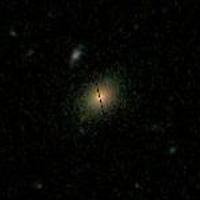 |
|
|
Q. Why record the rotation of the galaxy when it depends on your position? A different observer on the other side of the galaxy would observe it rotating the opposite way. And shouldn't they all be random?
A. Yes, they should be, but a recent investigation, involving many fewer galaxies,
suggested that the odds of seeing a clockwise or an anticlockwise galaxy changed depending on where you look in the sky. If this is true, it suggests we're missing something about how the Universe is organised on large scales, and so we decided - with your help - to see if the effect is real. We are also interested in the correlation s between neighbouring galaxies, for example whether a close pair of galaxies rotate the same way, as this contains information about the way galaxies form and the large-scale forces acting on them. All observers would
agree on such an observation. |
|
|
Q. What is this?
A. That is a very bright nearby star, getting in the way! Please click on 'STAR/DON'T KNOW' for these.
> SDSS Link: 587736620399591558 |
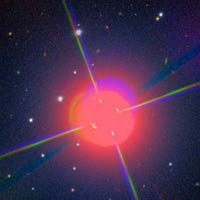 |
|
|
Q. What causes this?
A. Light scattering from a star, on the different chips of the CCD camera. Please ignore the effect, and click on 'STAR/DON'T KNOW'.
> SDSS Link: Chip Effect |
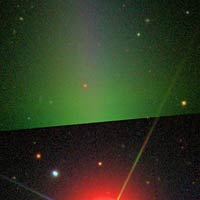 |
|
|
Q. How can I zoom in or out?
A. For now, click on the Galaxy Reference number, then click on the image in the Sky Server Object Explorer page. For the more technically minded, there is a lot more information there too (see below).
|
|
|
Q. What are these blue blobs?
A. These are irregular but star forming galaxies. Classify them as 'Don't know' if you can't see any hint of spiral structure.
> SDSS Link: 587734948588945528 |
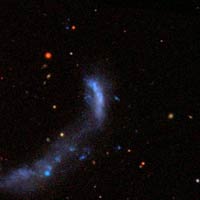 |
|
|
Q. How do I tell the difference between a merger and a projection effect?
A. If the galaxies are truly interacting then the should show signs of disruption; long, extended arms are typical, and the presence of more than one nucleus is also a good sign.
> SDSS Link: 587742629059362935 |
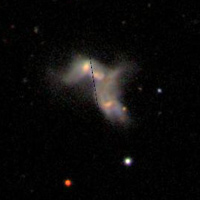 |
If they are merely overlapping or close to each other, and show no signs of disturbance, then they are probably just a chance projection and not a real merger.
> SDSS Link: 587736941981466667
It is also quite common for galaxies to group together in clusters, while not actually merging.
|
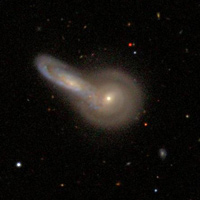 |
|
|
Q. I have noticed the colours seem to vary between spirals and ellipticals. Can we use this to help with our classifications?
A. Well spotted. Massive stars are blue, and also short lived (by astronomical standards, anyway) so we only see them where star formation has occured recently. That tends to be in spiral galaxies, but beware! We're trying to classify galaxies by shape, not by colour, in part because we would like to find star formation in elliptical galaxies so please use this extra information with caution. |
|
|
Q. I see a green/blue/red trail?
A. This is a satellite streaking across the sky while the image was taken. Ignore it, and click on the 'STAR/DON'T KNOW' button if there is no other central object to classify.
> SDSS Link: 587742568399765686 |
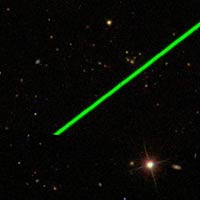 |
|
|
Q. What is this?
A. A star. Not all stars from our Milky Way Galaxy are big in our field of view, and a lot of little ones crop up too. You can often find out a bit more about an object by clicking on the Galaxy Reference number.
> SDSS Link: 587742627995254985 |
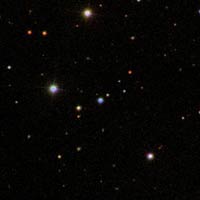 |
|
|
Q. This looks like a ring?
A. Indeed. These seem to be more common than we thought - they're the result of a particular kind of merger. Please drop us an email if you see one, and classify as a spiral galaxy with the 'EDGE ON/UNCLEAR' button.
> SDSS Link: 587729159512653982 |
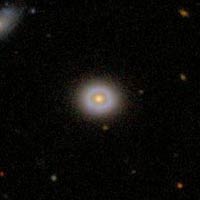 |
|
|
Q. How can I revisit an object?
A. We will have My Galaxies working soon. In the meantime make a note of the reference number, and go here:
http://cas.sdss.org/astro/en/tools/explore/obj.asp?id=587729159512653982
changing the ID number at the end of the link. |
|
|
Q. There are loads of galaxies in this image
A : Unless there are definite signs of interaction, please just classify the central one. The others will have separate catalogue numbers. Consider checking the "cross hairs" box if you want us to point out the galaxy at the centre. |
|
|
Q: Why are some images so blurry?
A:
Some of the galaxies in our Zoo are so small that we have to zoom in quite a lot for them not to be tiny dots. |
|
|
Q: You haven't answered my email!
A: Sorry. The Team is very small, and we've been rushed off our feet just keeping the site working. We promise we'll read everything you've sent eventually , but we might not send a reply if your question or comment has been addressed in these FAQ pages.
|
|
|
Q. Which option should I select when I cannot tell the rotation direction of a
spiral galaxy, but it is not edge-on?
A. Please use the 'EDGE-ON/UNCLEAR' spiral galaxy button. It is useful for us
to know which are spiral galaxies, even without rotation information. |
|
|
Q: Can I name my galaxies?
A: Sadly, astronomers are very attached to catalogue numbers, so there's
no way we can officially name them. Sorry! |
|
|
Q: If an object is red then is it moving away from
us?
A: Objects that move away from us appear
redder than if they were stationary. Likewise, objects get bluer if they move towards
us. This is called the Doppler effect. But that does not mean that all red things
are moving away from us, because somethings just are red anyway (like some stars)
and some galaxies emit blue light, for example. So we have to be careful with colours!
You actually need to look at their spectrum to be sure if it is moving away from
you. |
|
|
Q: How can I use the information on the SkyServer
page (found through clicking on the Galaxy Reference number)?
A. There can be a lot of information on
these pages. If a spectrum has been taken then a redshift will be available - this
is found under 'z' in the bottom table. This tells us how far the object is from
us (see below). Useful links can be found on the left, in particular Navigate lets
you click on nearby objects in the field and see their classification (in the top
right), and Neighbors helps you find detailed information about nearby objects.
We want you to always classify the object at the centre of an image, but here are
some examples of how this information might help or be of interest:
|
Example 1; What is the bright white thing?
Is it part of that galaxy
in the centre? The SkyServer tells us that the central
object has a redshift of 0.03, so we know it is not an object within our own galaxy
and therefore it is probably another galaxy. Using Navigate we can see that the
other object is just a star, and so we ignore it and just classify the galaxy at
the centre.
> SDSS Link: 587733397572550934
Similarly for
588017721181470790, 587739809414643861, 587736812601344256,
588017978888159236
|
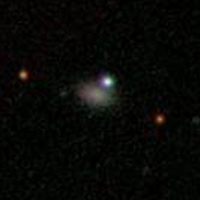 |
Example 2; Galaxy or star?
If the redshift
is available then this is easy to tell, and in this case it is a star because it
has a redshift of 0.
> SDSS Link: 587731172768350275 |
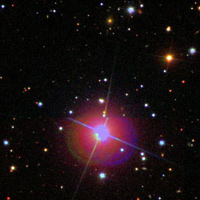 |
Example 3; What is this?
It looks like
a star, but from its redshift we can tell that it is far away from us and not in
our galaxy. The very sharp peaks in the spectrum indicate that it is in fact a 'quasar',
and please classify this as 'STAR/DON'T KNOW'.
See here for more information: http://en.wikipedia.org/wiki/Quasar
> SDSS Link: 588015509273510068 |
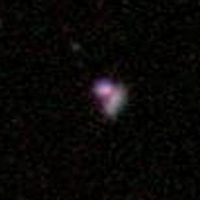 |
|
|
Q: What is 'redshift'?
A. It is the increase in the wavelength
of light emmitted from an object. It can be caused because the object is moving
away from us, or because the space in between us the object has expanded as the
light travelled towards us. In astronomy it gives us an indication of how far away
an object is. For more information see here: http://en.wikipedia.org/wiki/Redshift |
|
|
Q: What about Lenticuar galaxies, or other galaxis
which are disk-like but with no obvious spiral arms?
A. Please classify Lenticular galaxies
as 'ELLIPTICALS'. But in general classify disk-like galaxies as
'SPIRAL' and 'EDGE ON / UNCLEAR' if you
cannot discern the rotation. |
|
|
Q: What about irregular galaxies?
A. A truly irregular galaxy may be pretty
but it is not of much use to us, and so please classify under 'STAR/DON'T KNOW'. |
|
|
Q: Is it odd to get a group of galaxies together?
A. No, it is actually quite common. And
it makes for a nice picture!
> SDSS Link: 587739116316983582 |
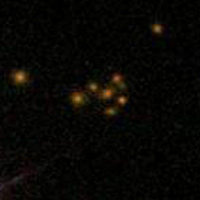 |
|
|
|
|